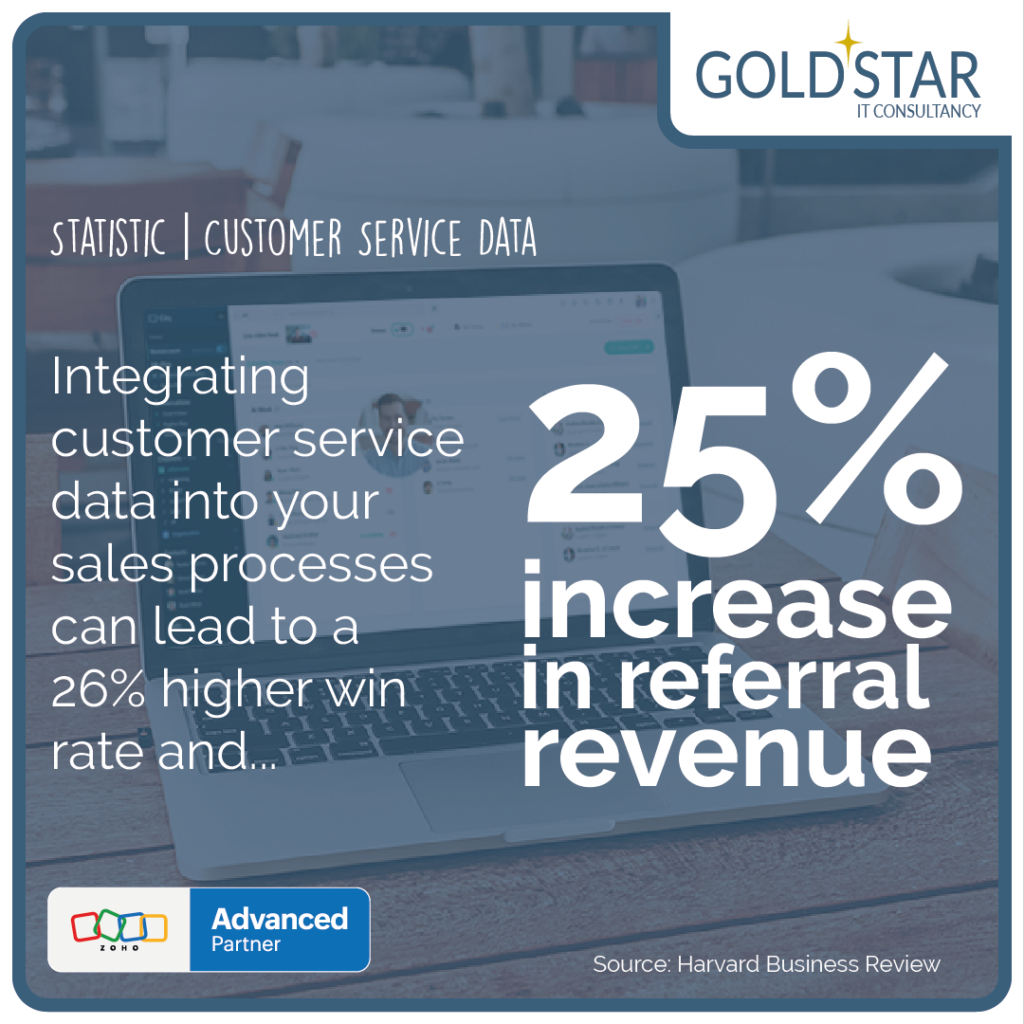Automating sales with your CRM and Customer Service data
This month, we delve into the realm of automating sales processes by harnessing the power of CRM and customer service data. By understanding the impact of data-driven automation, businesses can streamline sales workflows, improve customer interactions, and drive revenue growth.
Research by Harvard Business Review indicates that companies leveraging CRM data for sales activities experience a 29% increase in sales rep productivity and a 32% increase in forecast accuracy.
Similarly, integrating customer service data into sales processes leads to a 26% higher win rate and a 25% increase in revenue from referrals.

Understanding Data-Driven Sales Automation
Data-driven sales automation involves using insights from CRM and customer service data to optimise sales processes and enhance customer experiences.
By leveraging tools like Zoho CRM, Zoho Analytics, and Zoho Desk, businesses can analyse customer interactions, purchase histories, and service inquiries. This analysis helps identify patterns, anticipate needs, and personalise sales approaches effectively.
Additionally, leveraging automation tools such as email sequences, lead scoring algorithms, and predictive analytics from Zoho CRM enables sales teams to prioritise tasks, nurture leads effectively, and close deals efficiently.
In addition to these powerful tools offered by Zoho, businesses can further enhance their data-driven sales automation efforts by partnering with a Zoho expert like Goldstar. Zoho partners specialise in integrating separate products into a harmonious solution maximising the benefits and increasing your ROI.
Goldstar excels in custom configurations, setting up automated workflows, and providing training to sales teams, empowering businesses to harness the full potential of data-driven sales automation. With the guidance and support of a Zoho partner, businesses can expedite the implementation process, overcome any challenges, and accelerate their journey towards achieving sales excellence.

+

+

Benefits of Data-Driven Sales Automation
Combining analytics, CRM, and customer service solutions unlocks a realm of possibilities for businesses, revolutionizing how they engage with customers, streamline operations, and drive growth. Here’s a closer look at what data-driven sales automation could look like for your business through this powerful combination:
360-Degree Customer View
Integrating CRM and customer service data with analytics provides a comprehensive view of each customer. From purchase history and communication preferences to support interactions and feedback, businesses gain valuable insights into customer behaviour, preferences, and needs.
Personalised Customer Experiences
With rich data at their fingertips, businesses can personalize interactions at every touchpoint. By leveraging CRM data to understand customer preferences and combining it with insights from analytics, companies can tailor their communications, offers, and recommendations to each individual, enhancing customer satisfaction and loyalty.
Predictive Analytics for Sales Forecasting
By analysing past sales data, customer interactions, and market trends, businesses can use predictive analytics to forecast future sales with greater accuracy. This enables proactive planning, optimised inventory management, and more informed decision-making to capitalise on emerging opportunities and mitigate risks.
Proactive Issue Resolution
Integrating customer service data with analytics allows businesses to identify trends, patterns, and potential issues before they escalate. By leveraging predictive analytics, companies can anticipate customer needs, detect emerging problems, and proactively address them, leading to improved customer satisfaction and retention.
Optimised Marketing Campaigns
By combining CRM insights with analytics, businesses can segment their audience based on behaviour, preferences, and demographics. This enables targeted marketing campaigns that resonate with specific customer segments, increasing campaign effectiveness, and driving higher conversion rates.
Streamlined Operations
Analytics-driven insights can inform process improvements and operational efficiencies across the organisation. By analysing CRM and customer service data, businesses can identify bottlenecks, streamline workflows, and optimise resource allocation, leading to cost savings and improved productivity.
Continuous Improvement
With a data-driven approach, businesses can continuously monitor performance metrics, track KPIs, and measure the effectiveness of their strategies. By leveraging insights from analytics, CRM, and customer service solutions, companies can iterate on their processes, refine their strategies, and drive ongoing improvement in customer satisfaction, sales performance, and overall business success.
In essence, the combination of analytics, CRM, and customer service solutions empowers businesses to unlock deeper customer insights, drive personalised experiences, optimise operations, and fuel growth through data-driven decision-making and continuous improvement.
The impact of Data-Driven Sales Automation on your business
Implementing data-driven sales automation strategies can revolutionise your sales process and drive significant business outcomes. By integrating CRM and customer service data, businesses can gain a 360-degree view of their customers, identify cross-selling and upselling opportunities, and optimise sales funnels for maximum efficiency. Improved data accuracy and accessibility enable sales teams to make informed decisions, forecast trends accurately, and adapt strategies in real time to meet changing market demands.
Let’s make a comparison of two businesses, and see the practical differences data-driven sales automation can make to your business;
| Businesses with Data-Driven Sales Automation | Businesses without Data-Driven Sales Automation |
|---|---|
| 360-Degree Customer View Gain comprehensive insights into customer behaviour, preferences, and history. | Limited Insights into Customer Behaviour Misses opportunities to understand customer behavior, preferences, and purchase history due to fragmented data sources. |
| Access to CRM and Customer Service Data Access integrated data from CRM and customer service platforms for a unified view of customer interactions. | Relies on Fragmented Data Sources Struggles with accessing and integrating data from various sources, leading to incomplete customer records and inefficient analysis. |
| Identification of Cross-Selling Opportunities Identify and capitalise on cross-selling opportunities based on comprehensive customer profiles and purchase histories. | Missed Cross-Selling Opportunities Fails to capitalise on cross-selling opportunities due to lack of insights into customer purchasing patterns and preferences. |
| Optimisation of Sales Funnels Optimise sales funnels through data-driven insights, leading to streamlined processes and improved conversion rates. | Static, Unoptimised Sales Funnels Uses static sales funnels that are not optimised, resulting in slower conversion rates and missed revenue opportunities. |
| Informed Decision-Making Make data-driven decisions backed by insights into customer behaviour, market trends, and sales performance metrics. | Intuitive Decision-Making Makes decisions based on intuition rather than data, leading to suboptimal outcomes and missed opportunities for growth. |
| Accurate Trend Forecasting Forecast market trends accurately based on historical data and predictive analytics, allowing proactive strategy adjustments. | Inaccurate Trend Forecasting Lacks the ability to forecast trends accurately, resulting in reactive responses to market shifts and missed opportunities. |
| Real-Time Adaptation to Market Demands Quickly adapt sales strategies to changing market conditions and customer needs based on real-time data and analytics. | Slow, Reactive Adaptation to Market Changes Struggles to adapt sales strategies to changing market conditions, leading to missed opportunities and reduced competitiveness. |
| Enhanced Sales Performance Achieve consistent sales performance and growth through data-driven strategies and personalised customer engagement. | Inconsistent Sales Performance Experiences inconsistent sales performance and revenue growth due to reliance on individual efforts and reactive approaches. |
The outlook for businesses with
Data-Driven Sales Automation
Businesses embracing data-driven sales automation unlock a wealth of opportunities. With insights from integrated CRM and customer service data, they gain a comprehensive view of customers, enabling targeted sales strategies and streamlined processes.
Automation tools enhance efficiency, allowing for personalised interactions and timely responses to customer needs. Accurate forecasting and adaptive strategies drive increased sales, customer satisfaction, and overall business success.
By harnessing the power of data-driven automation, these businesses stay ahead of the competition and thrive in dynamic markets.
The potential for a business without Data-Driven Sales Automation
Businesses foregoing data-driven sales automation risk limited customer visibility and inefficient sales processes. Without insights from CRM and customer service data, they miss opportunities for personalised experiences and may struggle with disjointed data sources.
Intuition-based decision-making leads to suboptimal outcomes and slower adaptation to market changes, impacting competitiveness.
To avoid these pitfalls and unlock growth opportunities, businesses must prioritise implementing data-driven sales automation strategies.
Start automating your sales process from your own data
Now that we’ve explored the power of automating sales processes using CRM and customer service data, it’s time to take action.
Here are some questions to kickstart the process of automating your sales activities and leveraging data insights to drive better results.
Reach out to your team or try yourself – ask these questions. Their responses serve as a litmus test for your business’ readiness for automating your sales process.

- How are you currently leveraging CRM and customer service data in your sales process?
- Are there any repetitive tasks or manual processes that could be automated to improve efficiency?
- Have you explored automation tools and analytics platforms to optimise your sales workflows and drive better results?
- How do you plan to integrate automation into your existing sales strategies to enhance productivity and customer experiences?
By integrating automation into your sales strategies, you can streamline workflows, enhance productivity, and deliver personalised experiences that drive better results. Embrace the power of data-driven automation today to unlock new levels of efficiency and effectiveness in your sales efforts.
In today’s competitive marketplace, leveraging data-driven automation is essential for staying ahead of the curve. By harnessing the power of CRM and customer service data, businesses can unlock new opportunities, streamline sales processes, and drive sustainable growth. It’s time to embrace the future of sales automation and unlock the full potential of your business.
